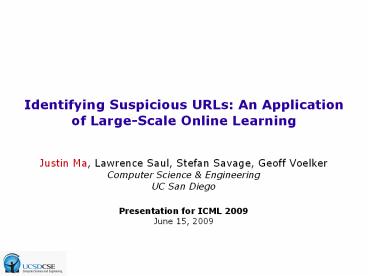Identifying Suspicious URLs: An Application of Large-Scale Online Learning - PowerPoint PPT Presentation
Title:
Identifying Suspicious URLs: An Application of Large-Scale Online Learning
Description:
http://fblight.com. http://mail.ru. 3. Problem in a Nutshell ... facebook.com. fblight.com. 4. Today's Talk. Problem. Approach. Learning to detect malicious URLs ... – PowerPoint PPT presentation
Number of Views:117
Avg rating:3.0/5.0
Title: Identifying Suspicious URLs: An Application of Large-Scale Online Learning
1
Identifying Suspicious URLs An Application of
Large-Scale Online Learning
- Justin Ma, Lawrence Saul, Stefan Savage, Geoff
Voelker - Computer Science Engineering
- UC San Diego
- Presentation for ICML 2009
- June 15, 2009
2
Detecting Malicious Web Sites
- Safe URL?
- Web exploit?
- Spam-advertised site?
- Phishing site?
URL Uniform Resource Locator http//www.cs.mcgi
ll.ca/icml2009/abstracts.html http//www.bfuduui
oo1fp.mobi/ws/ebayisapi.dll http//fblight.com h
ttp//mail.ru
Predict what is safe without committing to risky
actions
3
Problem in a Nutshell
- URL features to identify malicious Web sites
- Different classes of URLs
- Benign, spam, phishing, exploits, scams...
- For now, distinguish benign vs. malicious
facebook.com
fblight.com
4
Today's Talk
- Problem
- Approach
- Learning to detect malicious URLs
- Challenges scale and non-stationarity
- Evaluations
- Need for large, fresh training sets
- Online learning
- Conclusion
5
State of the Practice
- Current approaches
- Blacklists
- Learning on hand-tuned features
- Limitations
- Cannot learn from newest examples quickly
- Cannot quickly adapt to newest features
- Arms race fast feedback cycle is critical
More automated approach?
6
Live URL Classification System
Label
Example
Hypothesis
7
Live Training Feed
- Malicious URLs (spamming and phishing)
- 6,0007,500 per day from Web mail provider
- Benign URLs
- From Yahoo Web directory
- Total of 20,000 URLs per day
- Live collection since Jan. 5, 2009
- Months of data
- Two million examples after 100 days
8
Feature vector construction
http//www.bfuduuioo1fp.mobi/ws/ebayisapi.dll
WHOIS registration 3/25/2009 Hosted from
208.78.240.0/22 IP hosted in San Mateo Connection
speed T1 Has DNS PTR record? Yes Registrant
Chad ...
_ _ 0 0 0 1 1 1 1 0 1 1
Host-based
Lexical
Real-valued
60 features
1.8 million
1.1 million
GROWING
Day 100
9
Live URL Classficiation System
Online learning
10
Practical Challenges of ML in Systems
- Industrial concerns
- Scale millions of examples, features
- Non-stationarity examples change over time (arms
race w/ criminals) - Pivotal decision batch or online?
11
Batch vs. Online Learning
- Batch/offline learning
- SVM, logistic regression, decision trees, etc
- Multiple passes over data
- No incremental updates
- Potentially high memory and processing overhead
- Online learning
- Perceptron-style algorithms
- Single pass over data
- Incremental updates
- Low memory and processing overheard
Online learning addresses scale and
non-stationarity
12
Evaluations
- Online learning for URL reputation
- Need for large, fresh training sets
- Comparing online algorithms
13
Need lots of fresh training data?
SVM trained once
SVM retrained daily
- Fresh data helps
14
Need lots of fresh training data?
SVM trained once on 2 weeks
SVM w/ 2-week sliding window
- Fresh data helps
- More data helps
15
Which online algorithm?
- Perceptron
- Stochastic Gradient Descent for Logistic
Regression - Confidence-Weighted Learning
16
Perceptron
Rosenblatt, 1958
- Convergence result
-
radius
-
-
Number of mistakes
-
-
margin
-
- Update on each mistake
17
Logistic Regression with SGD
Bottou, 1998
- Log likelihood
- For every example
where
Proportional
18
Confidence-Weighted Learning
Dredze et al., 2008 Crammer et al., 2009
- Maintain Gaussian distribution over weight vector
- Constrained problem
- Closed-form update
Treat features differently
19
Which online algorithms?
Perceptron
20
Which online algorithms?
Perceptron
LR w/ SGD
- Proportional update helps
21
Which online algorithms?
Perceptron
LR w/ SGD
Confidence-Weighted
- Proportional update helps
- Per-feature confidence really helps
22
Batch...
Batch
- Fresh data helps
- More data helps
23
Batch vs. Online
Batch
Confidence-Weighted
- Fresh data helps
- More data helps
- Online matches batch
24
Conclusion
- Detecting malicious URLs
- Relevant real-world problem
- Successful application of online learning
- Confidence-Weighted vs. Batch
- As accurate
- More adaptive
- Less resources
- Future work
- Scaling up for deployment

